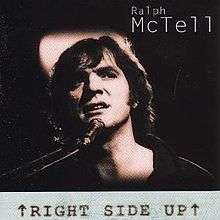Right Side Up
Right Side Up is an album by Ralph McTell released in 1976 by Warner Bros. Records/WEA, recorded at Air Studios in London by Pete Henderson and Mike Stavrou, and produced by Ralph McTell and Peter Swettenham (one-time member of band Grapefruit).
| Right Side Up | ||||
|---|---|---|---|---|
 | ||||
| Studio album by Ralph McTell | ||||
| Released | 1976 | |||
| Studio | Air Studios, London | |||
| Genre | Folk | |||
| Length | 32:44 | |||
| Label | Warner Bros. Records/WEA | |||
| Producer | Ralph McTell, Peter Swettenham | |||
| Ralph McTell chronology | ||||
| ||||
Musicians who appear on the album include Danny Thompson, (double bass), John Stevens and Pick Withers - (drums) - Rod Clements (of Lindisfarne), - Dave Pegg (from Fairport Convention), bass players. Backing vocals were provided by Tony Rivers - of The Castaways - Ken Gold and John Perry (also one-time member of band Grapefruit). John Martyn played guitar on "River Rising".[1]
Track listing
All tracks composed by Ralph McTell; except where indicated
- "San Diego Serenade" (Tom Waits) - (McTell - "I've always admired Tom Waits writing for both his melody and his wonderfully evocative lyrics")
- "Naomi"
- "Tequila Sunset"
- "Weather the Storm" - (McTell - "It remains one of my most requested pieces in live work")
- "River Rising"
- "From Clare to Here" - (McTell - "A chance remark from a fellow building site labourer remembered from 1963 as " it's a long way from Clare to here."
- "Chairman and the Little Man"
- "Country Boys" - (McTell: "Cornwall was in my mind when I wrote this, and Ry Cooder was on everybody's turntable")
- "Slow Burning Companion"
- "Nightmares"
- "May You Never" (John Martyn) - (McTell - "John Martyn has written so many beautiful songs, but I guess this is still my favourite.")
- "Song for Ireland" (additional track, learnt by McTell from the version by Dick Gaughan, written by Phil Colclough originally released in 1982, added to re-release of the album)
Personnel
- Ralph McTell - vocals, acoustic guitar
- John Martyn - electric guitar on "River Rising"
- Dave Pegg, Rod Clements - bass guitar
- Danny Thompson - acoustic bass
- Sam Mitchell - dobro
- Graham Preskett - keyboards, string arrangements
- Peter Swettenham - keyboards
- John Stevens, Pick Withers - drums, percussion
- John Perry, Ken Gold, Tony Rivers - backing vocals
- Technical
- Mike Stavrou, Peter Henderson - mixing
- Mike Dymond - photography
gollark: I don't think that's even our actual IP.
gollark: I agree.
gollark: Wrong.
gollark: ↑ an image of zachary
gollark: https://images-ext-1.discordapp.net/external/oq_T5EpNU0N9LPg4z43Mz8O1Z8g_icqg9rhWaKgyb08/https/raw.githubusercontent.com/opencomputeproject/Time-Appliance-Project/master/Time-Card/images/idea.png?width=1108&height=623
References
- Sleeve notes, CD re-release 2001
External links
This article is issued from Wikipedia. The text is licensed under Creative Commons - Attribution - Sharealike. Additional terms may apply for the media files.